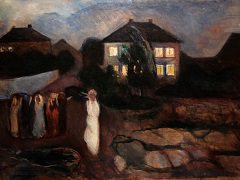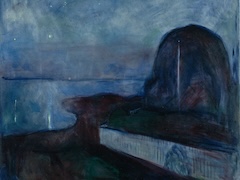By The Death Bed, 1896 by Edvard Munch

"Illness, madness and death were the black angels that watched over my cradle and have since followed me through life," Munch wrote in his notes, almost as an explanation for all the death-related motifs that were to form a large, significant part of his pictorial world.
The second half of the 19th century witnessed a turn in artistic thematics and mode of expression. With the advent of realism in the 1870s and 1880s, everyday life in society, along with its darker sides, were preferred to the more idealising depictions of people and landscapes of Romanticism.
Consumption and tuberculosis were among the frightening illnesses of the age, and a favourite motif for contemporary visual art. Most families were affected in one way or other by these disease. Munch experienced the disease twice among those closest to him, and on one occasion he too was struck down by it: "One Christmas Eve, when 13 years old, I lie in my bed. The blood trickles from my mouth - the fever rages in my veins - fear cries out deep within me. Now, now, in just a moment, you will meet your Maker and be sentenced for eternity."i The horror and the impressions from his mother's death in 1868, when he was five years old, shook him and the family. Now he himself could feel the fever rampaging through his body, and his chances of a future were in jeopardy. In particular, the death of his sister, Sofie, at the age of 15 in 1877 left ineradicable traces in his soul, but were also to lay the foundation for a number of his major works.
Despite the fact that illness and death were frequent motifs in contemporary art, Munch's painting met with considerable resistance when he exhibited By the Death Bed in 1896 - and some people even tried to question the mental state of the artist. His simplification of form, choice of colours and intensity were extremely alien and incomprehensible to many.




















